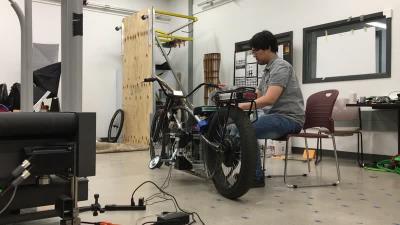Description
Bicycles and motorcycles offer maneuverability, energy efficiency and acceleration that four wheeled vehicles cannot offer given similar budget for. Two wheeled vehicles have drastically different dynamics from four wheeled vehicles due to their instability and gyroscopic effect from their wheels.
This thesis focuses on self-stabilization of a motorcycle using an active control momentum gyroscope (CMG) and validation of this multi-degree-of-freedom system’s mathematical model. Physical platform was created to mimic the simulation as accurately as possible and all components used were justified. This process involves derivation of a 3 Degree-of-Freedom (DOF) system’s forward kinematics and its Jacobian matrix, simulation analysis of different controller algorithms, setting the system and subsystem specifications, and real system experimentation and data analysis.
A Jacobian matrix was used to calculate accurately decomposed resultant angular velocities which are used to create the dynamics model of the system torque using the Euler-Lagrange method. This produces a nonlinear second order differential equation that is modeled using MATLAB/Simulink. PID, and cascaded feedback loop are tested in this Simulink model. Cascaded feedback loop shows most promises in the simulation analysis. Therefore, system specifications are calculated according to the data produced by this controller method. The model validation is executed using the Vicon motion capture system which captured the roll angle of the motorcycle. This work contributes to creating a set of procedures for creating a validated dynamic model for a CMG stabilized motorcycle which can be used to create variants of other self-stabilizing motorcycle system.
This thesis focuses on self-stabilization of a motorcycle using an active control momentum gyroscope (CMG) and validation of this multi-degree-of-freedom system’s mathematical model. Physical platform was created to mimic the simulation as accurately as possible and all components used were justified. This process involves derivation of a 3 Degree-of-Freedom (DOF) system’s forward kinematics and its Jacobian matrix, simulation analysis of different controller algorithms, setting the system and subsystem specifications, and real system experimentation and data analysis.
A Jacobian matrix was used to calculate accurately decomposed resultant angular velocities which are used to create the dynamics model of the system torque using the Euler-Lagrange method. This produces a nonlinear second order differential equation that is modeled using MATLAB/Simulink. PID, and cascaded feedback loop are tested in this Simulink model. Cascaded feedback loop shows most promises in the simulation analysis. Therefore, system specifications are calculated according to the data produced by this controller method. The model validation is executed using the Vicon motion capture system which captured the roll angle of the motorcycle. This work contributes to creating a set of procedures for creating a validated dynamic model for a CMG stabilized motorcycle which can be used to create variants of other self-stabilizing motorcycle system.
Included in this item (4)

Permanent Link

Permanent Link
Load Player

Permanent Link
Load Player
Details
Title
- Balancing Control and Model Validation of Self-Stabilizing Motorcycle
Contributors
Agent
- Moon, Hansol (Author)
- Zhang, Wenlong (Thesis advisor)
- Frank, Daniel (Committee member)
- Delp, Deana (Committee member)
- Sugar, Thomas (Committee member)
- Arizona State University (Publisher)
Date Created
The date the item was original created (prior to any relationship with the ASU Digital Repositories.)
2020
Subjects
Collections this item is in
Note
- Masters Thesis Engineering 2020
